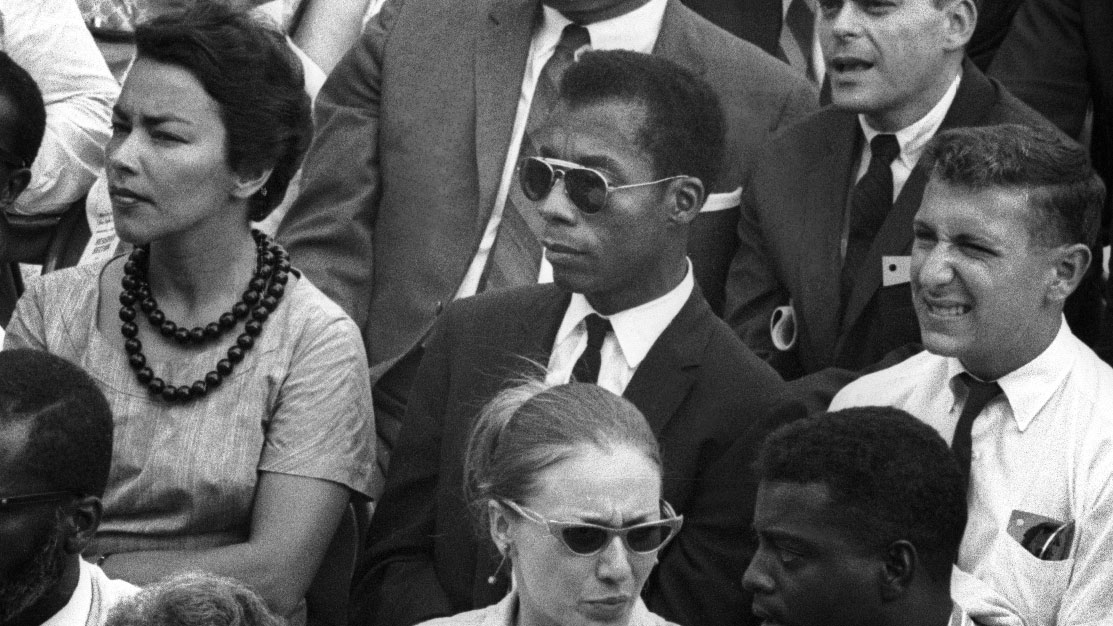Fluid Camera Moves Elevate the Power of Baldwin’s Words
Director Raoul Peck took 10 years to make his Oscar-nominated documentary, I Am Not Your Negro, yet never deviated from its singular point of view: the words of novelist and social critic James Baldwin. Through the layered intersection of archival and contemporary images, Peck’s film brings new urgency to Baldwin’s writing, particularly Remember This House, his unpublished memoir about the intersecting lives and deaths of his friends Martin Luther King, Jr., Malcolm X and Medgar Evers. “The conundrum of color is the inheritance of every American, be he/she legally or actually Black or White,” Baldwin wrote in the 1984 preface to the reissue of Notes of a Native Son, his 1955 classic. “It is a fearful inheritance,” one that lends “an unadmitted icy panic coiled beneath the scaffolding of these present days.” As Peck’s film reveals, it coils there still.
Although archival photographs and film make up the majority of the documentary’s images, on-the-street coverage of protests in Ferguson, MO, and B-roll shot on location in New York and in the South (helmed by Independent Spirit Award-winning documentarians Bill and Turner Ross) complete Peck’s visual montage. Emmy-nominated DP Henry Adebonojo, who shot b-roll in New York, also closes the film with his gorgeously stylized portraits of current New York residents of color.
“Raoul’s overall concept, for the entire film and for every image we shot and archival image he chose, was to unite the past with the present through Baldwin’s words,” Adebonojo says. “He therefore wanted a continuity in African-American portraiture, beginning in the 19th century on through to the stuff we shot, that focuses on the dignity of the individual. He was very particular about the looks he wanted, so there was some casting done and, before that, he had me do some scouting for possible locations.” Filming in one day at Bronx Community College with the Canon C300 Mark II and a mix of natural light and HMIs, Adebonojo was able to seamlessly transition from sepia photographs of black Americans to colorful modern-day portraits in 4K.
“I’ve always been impressed with Canon’s color science, especially as it relates to African-American skin tones,” he says. “And we knew we were going to be shooting a variety of those skin tones. I also wanted more shallow depth of field than I could accomplish with the Canon lenses I already owned, so I used Canon Cine Primes with the C300 and mostly shot almost wide open. Even with such shallow depth of field, the sharpness was exactly what I needed it to be.”
Adebonojo shot the B-roll footage of New York with his Panasonic GH4 DSLR but was drawn to the C300’s small size and internal recording features for the later shoot. “We had a really small crew and a very tight schedule, and being able to shoot 4K internally on the C300 without an external recorder to capture the image meant we could shoot close to 40 people that day and still make it all happen pretty quickly,” he says. Peck didn’t use every shot in the final cut, though he could have without much finessing in post. Adebonojo says he was able to keep the background uniform in each one through exposure and a bit of “wrestling with the changing light.”
The power of the closing portraits come not just from the subjects themselves but from the nearly imperceptible pan and zoom within the frame, a conscious creative choice Peck defined for his DPs as “a certain amount of grace.” “That idea informed everything I shot,” says Adebonojo. “It was very important to Raoul that anything with movement be captured in a very graceful, subtle manner. The film is literally Baldwin sitting with his own thoughts, and even when we see him on camera, that gracefulness of his presence needed to be implicit in every camera move. And if the camera wasn’t moving, Raoul wanted what was moving within the frame to express that idea. He was very particular about what he wanted each frame to feel like.”
Samuel L. Jackson’s simmering yet understated narration, which brings Baldwin’s words to life, was also part of Peck’s plan. “Most people know Sam Jackson as a very boisterous actor,” says Adebonojo, “and if Raoul could get that kind of subtle performance out of him, you can understand how his original vision drove every aspect of this film with absolute clarity.”
It’s also a tremendous tribute to James Baldwin, he adds, that his thoughts alone could form the foundation of the film. “What Baldwin urges us all to do is just to be better human beings, regardless of who we are,” Adebonojo says. “He challenges us to look at the bigger picture. If any one group of us within the family unit of America are weary, then we are all weary, whether we realize it or not.”
I Am Not Your Negro remains in theatrical release. It is also available on DVD and Blu-ray and for streaming on iTunes and Amazon Prime.
Crafts: Shooting
Sections: Creativity
Topics: c300 mark ii Canon cinema prime ef lenses documentary Henry Adebonojo James Baldwin Panasonic GH4 Raoul Peck
Did you enjoy this article? Sign up to receive the StudioDaily Fix eletter containing the latest stories, including news, videos, interviews, reviews and more.













Leave a Reply